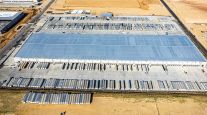New Facility to Enhance Inspection Capabilities of Trucks Entering United States in California
This story appears in the Dec. 3 print edition of Transport Topics.
Customs officials from the United States and Mexico said they will soon open a facility in Tijuana, Mexico, that will expand inspection capabilities for trucks entering the United States and combine export and import operations.
The two countries have not yet set a date for launching the pilot program for the facility at the Otay Mesa Port of Entry in Baja California, but construction on the building has been completed, Joanne Ferreira, a spokeswoman for U.S. Customs and Border Protection, told Transport Topics.
The pilot program “will facilitate the identification and screening of cargo prior to entering the United States and will permit the efficient and expedited clearance of the increasing volume of trade between the United States and Mexico,” Ferreira said. It is separate from the ongoing pilot program that allows some Mexican carriers to drive into the interior of the United States.
The Otay Mesa facility will only handle perishable agricultural goods during the pilot program, said Ferreira, who did not say how long the pilot will last once it is launched.
Nelson Balido, president of the Border Trade Alliance, called the inspection facility the “customs inspection station of the future.” Balido toured the facility recently, and noted its high-tech systems and the ability for Mexican and U.S. officials to work so closely together.
“We believe that in order to be able to expand and compete with Asia trade, this is the kind of cooperation we need on both sides of the border,” Balido said.
Mexico’s Servicio de Administración Tributaria, the agency that oversees customs and taxing, built the facility in a former electronics warehouse for about $10 million, Balido said. After trucks clear the facility, they will go straight to a specialized lane to cross the border.
Trucks still will be subject to further CBP inspections if the agency finds it necessary, but that probably will be rare, Balido said. Trucks also will need to go through a safety and emissions inspection facility operated by the California Highway Patrol, as they do now.
Mexico hoped to launch the program before President Felipe Calderón left office, Balido said. But Calderón was scheduled to depart Dec. 1, when Enrique Peña Nieto would become president for a six-year term.
The program will still launch, Balido said, but Peña Nieto’s inauguration would put the timeline in doubt.
The Otay Mesa building is part of the 21st Century Border Management Initiative, launched by both countries in 2010. Other projects in the initiative include a U.S.-built pre-clearance facility for air cargo at the Laredo International Airport in Texas and a pre-clearance trade zone near Ciudad Juárez in the Mexican state of Chihuahua. That trade zone, which includes an electronics factory, is still in the works, Balido said.
Alejandra Mier y Teran, executive director of the Otay Mesa Chamber of Commerce on the California side of the border, also has toured the new facility.
“I think this is unprecedented — in a positive way. If this pilot program works, it’s an opportunity to expand ports of entry,” she said. “It’s an incredible opportunity for the trade community.”
The facility will greatly improve conditions at the Otay Mesa crossing and speed up trade, Mier y Teran said.
Mexico focused the initial pilot on perishables because they are especially sensitive to long waiting times for inspections, she said. The building’s inspection stations are refrigerated in an attempt to further protect those items.
If the pilot is successful, the building will likely expand to inspect other commodities, said Martin Rojas, vice president of security and operations for American Trucking Associations.
“From our perspective, it’s a great sort of precedent setting, not just on the southern border but potentially for the northern border, too,” Rojas said. “Pre-clearance is something that we at ATA have been looking for a long time. So this is a very positive development.”
Rojas said the two countries are still working out “minor details” related to the project.




